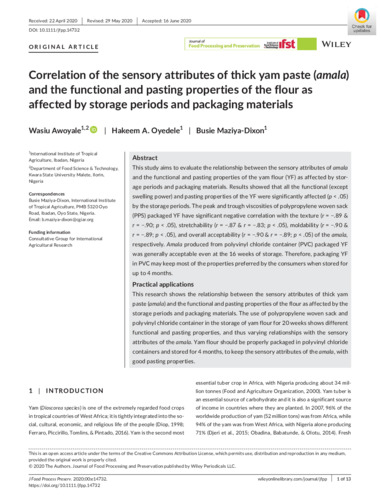Correlation of the sensory attributes of thick yam paste (amala) and the functional and pasting properties of the flour as affected by storage periods and packaging materials
Abstract
This study aims to evaluate the relationship between the sensory attributes of amala and the functional and pasting properties of the yam flour (YF) as affected by storage periods and packaging materials. Results showed that all the functional (except swelling power) and pasting properties of the YF were significantly affected (p < .05) by the storage periods. The peak and trough viscosities of polypropylene woven sack (PPS) packaged YF have significant negative correlation with the texture (r = −.89 & r = −.90; p < .05), stretchability (r = −.87 & r = −.83; p < .05), moldability (r = −.90 & r = −.89; p < .05), and overall acceptability (r = −.90 & r = −.89; p < .05) of the amala, respectively. Amala produced from polyvinyl chloride container (PVC) packaged YF was generally acceptable even at the 16 weeks of storage. Therefore, packaging YF in PVC may keep most of the properties preferred by the consumers when stored for up to 4 months.
Practical applications
This research shows the relationship between the sensory attributes of thick yam paste (amala) and the functional and pasting properties of the flour as affected by the storage periods and packaging materials. The use of polypropylene woven sack and polyvinyl chloride container in the storage of yam flour for 20 weeks shows different functional and pasting properties, and thus varying relationships with the sensory attributes of the amala. Yam flour should be properly packaged in polyvinyl chloride containers and stored for 4 months, to keep the sensory attributes of the amala, with good pasting properties.

